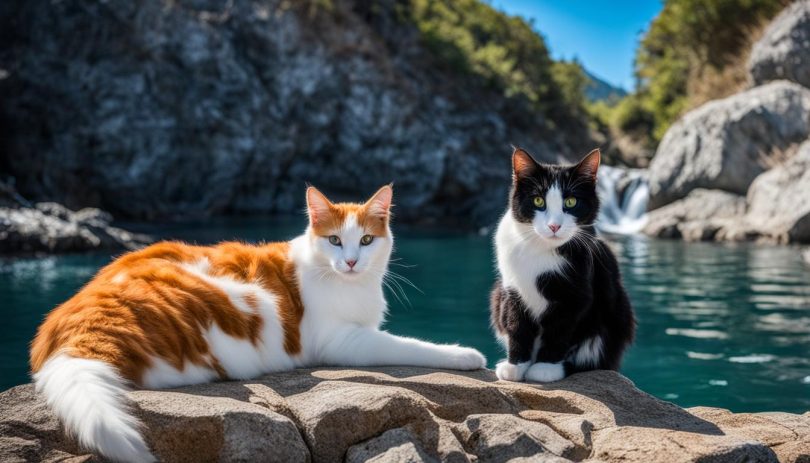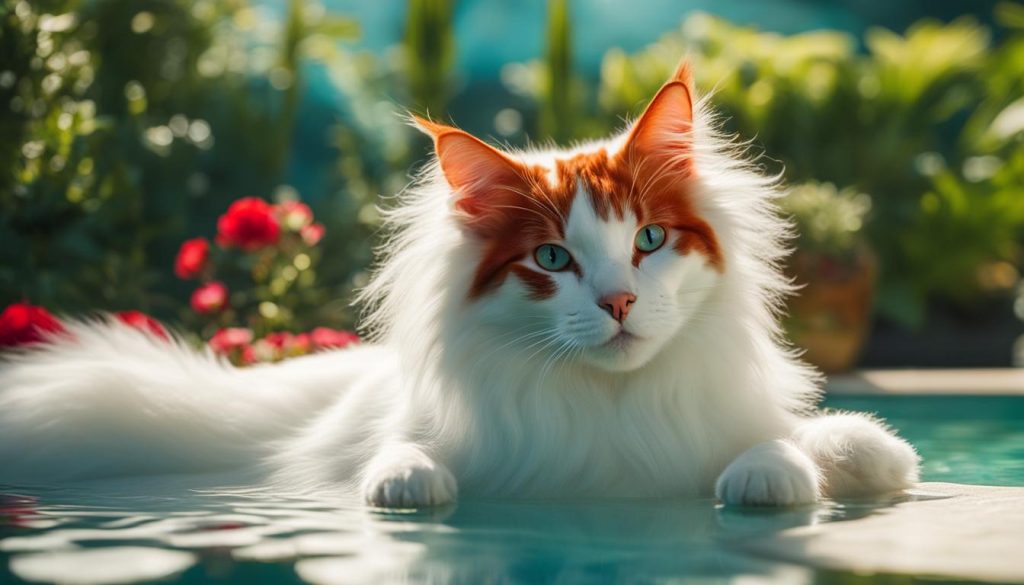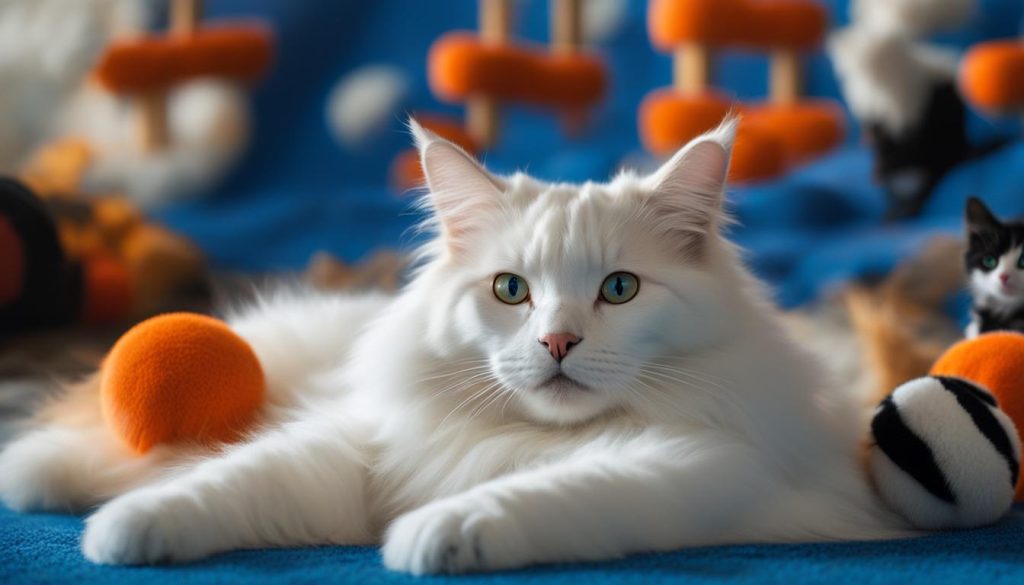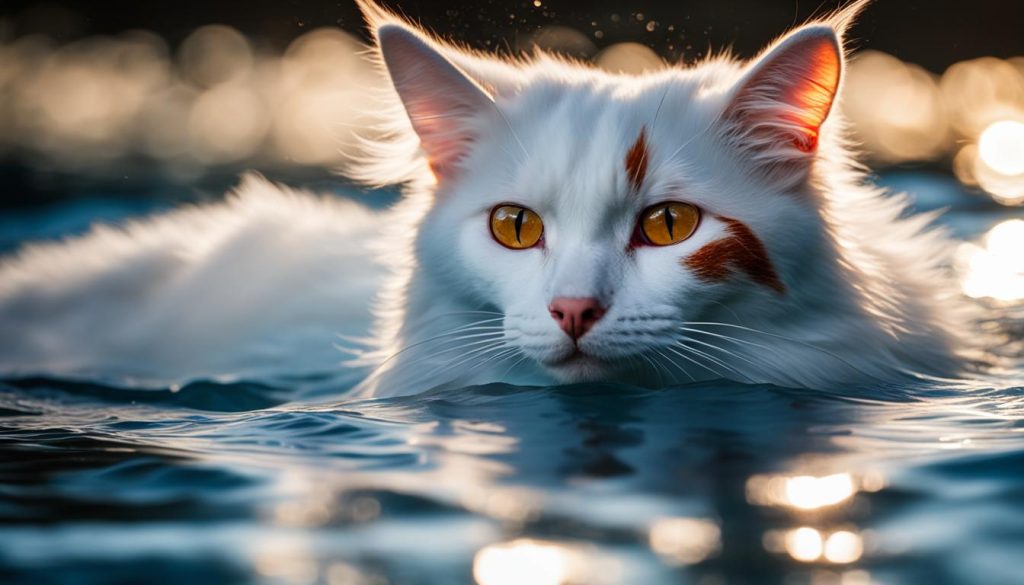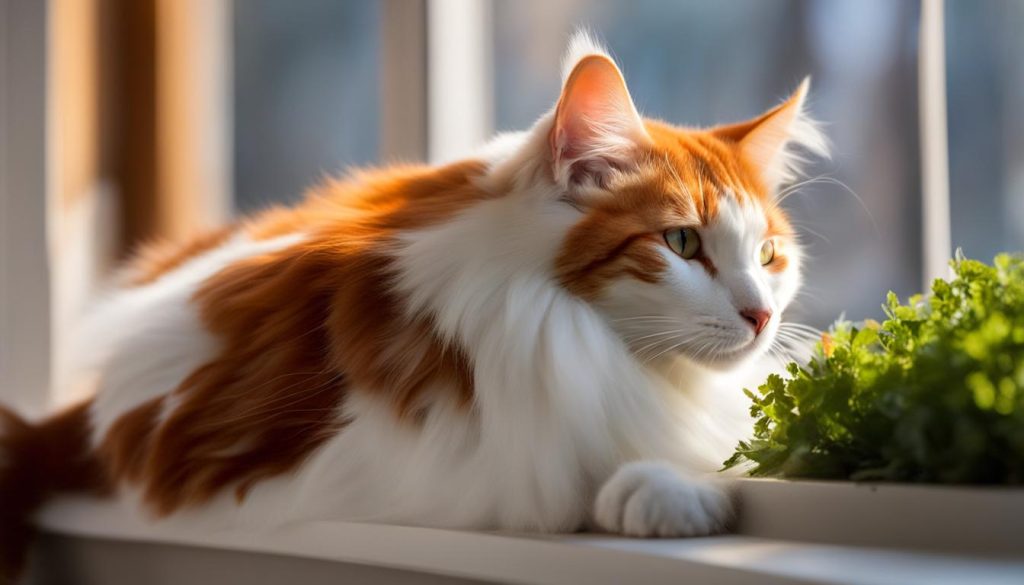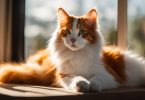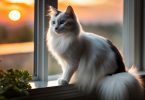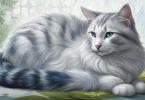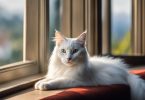Glimpse into the world of Turkish Van cats and discover the allure of their rarity. With their unique features and stunning appearance, Turkish Van cats have captivated the hearts of many. Originating from southeast Turkey, these feline treasures are a testament to their scarce existence. Let’s embark on a journey to uncover what makes Turkish Van cats so rare and extraordinary.
Key Takeaways:
- Turkish Van cats are a rare breed coveted for their unique features and stunning appearance.
- They originated from southeast Turkey, adding to their rarity and mystique.
- The breed’s history, spanning across different regions, contributes to its scarcity.
- Turkish Van cats have a distinct coat pattern and eye colors that make them stand out.
- Caring for a Turkish Van cat requires regular grooming and veterinary care.
Turkish Van Cats: Breed History
Turkish Van cats have a rich breed history that adds to their rarity. They originated from a region that spans southeast Turkey, Iran, Iraq, and Russia. The exact origins of Turkish Van cats remain uncertain, but some reports suggest that they may have been brought to Europe by Crusaders.
The breed arrived in the UK in 1955 and gained recognition from the Governing Council of the Cat Fancy in 1969. It wasn’t until 1982 that Turkish Van cats made their way to the United States and were recognized by the Cat Fanciers’ Association in 1994.
The journey of Turkish Van cats from their ancient origins to becoming recognized breeds in different parts of the world is a testament to their uniqueness and charm.
Table: Arrival of Turkish Van Cats in Different Countries
| Country | Year of Arrival |
|---|---|
| United Kingdom | 1955 |
| United States | 1982 |
As Turkish Van cats continue to captivate cat enthusiasts around the world, their breed history remains a fascinating tale that highlights their rare and exotic nature.
Turkish Van Cats: Breed Description
Turkish Van cats are known for their unique breed description, which sets them apart from other cat breeds. They have a glistening chalk-white coat with colored patches limited to the tail and head, creating a striking contrast. The head patches should ideally form a symmetrical inverted V pattern, adding to the beauty of the cat’s appearance. The coat texture of Turkish Van cats is soft and cashmere-like, and their eye colors can be either amber, blue, or a combination of both.
One of the most captivating features of Turkish Van cats is their coat, which is predominantly chalk-white. The limited patches of color on their head and tail create a visually stunning contrast. The head patches, when forming a symmetrical inverted V pattern, further enhance their unique appearance.
In addition to their striking coat, Turkish Van cats boast a luxurious coat texture that is soft and reminiscent of cashmere. Running your fingers through their fur is a delightful tactile experience. Their eye colors are equally enchanting, with some cats having beautiful amber eyes, while others sport mesmerizing blue eyes. Certain Turkish Van cats even have eyes that are a combination of both colors, adding an extra element of intrigue to their already captivating appearance.
Overall, Turkish Van cats possess a breed description that is as unique as they are. From their chalk-white coat and inverted V pattern to their soft coat texture and captivating eye colors, Turkish Van cats are truly a sight to behold.
| Coat Color | Eye Color |
|---|---|
| Chalk-white with limited color patches | Amber |
| Blue | |
| Combination of amber and blue |
5 Fascinating Facts about Turkish Van Cats
Turkish Van cats are not only rare but also have some intriguing facts that make them even more fascinating. One of these facts is the presence of the piebald gene, which gives them their unique coat pattern. The piebald gene causes the white areas of their coat to be devoid of pigment, creating the distinct patches of color. This gene is responsible for the striking patterns seen in Turkish Van cats, making them truly one-of-a-kind.
Another interesting fact about Turkish Van cats is their love for water. While not all Turkish Vans enjoy swimming, many of them have a natural affinity for water. They are known to splash around in shallow pools, play with water from faucets, and even dip their paws into their water bowls. This unique characteristic sets Turkish Van cats apart from other cat breeds and adds to their charm.
Despite their similar coat pattern, Turkish Van cats are distinct from Turkish Angora cats. While both breeds share the “van pattern” – a mostly white coat with colored patches limited to the head and tail – Turkish Van cats have a more substantial and muscular body structure. Turkish Angora cats, on the other hand, have a sleeker and more delicate appearance. It’s important to recognize the differences between these two breeds while appreciating their beauty and individual characteristics.
| Fact | Description |
|---|---|
| Piebald gene | The piebald gene gives Turkish Van cats their unique coat pattern, with distinct patches of color on a white coat. |
| Love for water | Many Turkish Van cats have a natural affinity for water and enjoy splashing around or playing with water. |
| Distinct from Turkish Angora | Turkish Van cats have a more substantial and muscular body structure compared to the sleeker appearance of Turkish Angora cats. |
| Van pattern | The “van pattern” is a coat pattern shared by Turkish Van cats, Turkish Angora cats, and other cat breeds, characterized by a mostly white coat with colored patches limited to the head and tail. |
Turkish Van cats are truly captivating creatures with their rarity, unique coat patterns, and distinct characteristics. Whether it’s their piebald gene, love for water, or their differences from Turkish Angora cats, Turkish Van cats continue to intrigue and enchant cat enthusiasts worldwide.
Is Your Cat a Turkish Van?
If you’ve been mesmerized by the unique beauty of Turkish Van cats and are wondering if your own feline companion is a Turkish Van or simply resembles the breed, there are a few key factors to consider. To be classified as a Turkish Van, a cat must be registered from an ethical breeder who can provide documentation of its lineage. This ensures that the cat is a purebred Turkish Van with the distinct coat pattern and limited color patches that are characteristic of the breed.
While some cats may bear a resemblance to Turkish Vans, it’s important to note that lookalike cats are not considered purebred Turkish Vans unless they have the proper documentation to support their lineage. These cats may have similar coat patterns, but they may not possess the other unique characteristics that define the breed. If you are unsure about the breed of your cat, consulting with a veterinarian or a cat breed expert can help provide clarity.
The beauty of lookalike cats is that they can still bring joy and companionship to their owners. Their unique markings and personalities make them special in their own right, even if they are not purebred Turkish Vans. Whether your cat is a Turkish Van or a lookalike, it’s important to appreciate and embrace the unique characteristics that make them who they are.
Remember, the bond you share with your feline friend transcends breed and appearance. Regardless of whether your cat is a Turkish Van or a lookalike, they are a cherished member of your family, bringing love, joy, and companionship to your home.
Table: Differences Between Turkish Van Cats and Lookalike Cats
| Turkish Van Cats | Lookalike Cats | |
|---|---|---|
| Coat Pattern | Distinctive chalk-white coat with limited color patches | May have similar coat patterns, but not limited to Turkish Van characteristics |
| Registered | Registered from an ethical breeder with documentation of lineage | May not have proper documentation to support lineage |
| Distinct Characteristics | Unique traits such as love for water and active nature | May not possess the same distinctive traits as Turkish Van cats |
While Turkish Van cats are rare and known for their distinctive features, it’s essential to appreciate the beauty of all cats, whether they are purebred Turkish Vans or lookalikes. Each cat is unique and brings their own charm to our lives, adding joy and companionship to our homes.
Turkish Van Cats as Excellent Swimmers
One of the most fascinating and unique traits of Turkish Van cats is their exceptional swimming ability. Unlike most cat breeds, Turkish Vans have a natural affinity for water and thoroughly enjoy spending time in it. Whether it’s a bathtub, a pool, or even a fountain, these feline swimmers are known to take the plunge and paddle away with delight.
The love for water exhibited by Turkish Van cats can be attributed to their ancestral roots in the Van region of Turkey, which is known for its numerous lakes and bodies of water. Over generations, Turkish Vans have developed a strong instinct for swimming, making them one of the few feline breeds with such aquatic skills.
“Watching my Turkish Van cat gracefully swim through the water brings me so much joy. It’s truly a sight to behold!” – Turkish Van cat owner
The unique adaptations of Turkish Van cats contribute to their swimming abilities. Their water-resistant coat, which feels almost like cashmere, helps keep them buoyant and insulates them from the cold. Additionally, their muscular bodies provide them with the strength and agility required for effortless swimming.
Swimming Safety Tips for Turkish Van Cats
- Always supervise your Turkish Van cat when it’s near water to ensure their safety.
- Introduce them to water gradually and make sure they are comfortable before encouraging them to swim.
- Never force your Turkish Van cat into the water if they show signs of fear or resistance.
- Provide opportunities for your Turkish Van cat to swim in a controlled environment, such as a shallow pool or designated cat-friendly swimming area.
- After swimming, dry your Turkish Van cat thoroughly and make sure they are warm to prevent any potential health issues.
Embracing the remarkable swimming abilities of Turkish Van cats is part of appreciating their unique qualities. So, if you own a Turkish Van, why not create a delightful swimming experience for them and witness their undeniable love for water firsthand!
Turkish Van Cats as Active and Playful Pets
Turkish Van cats are not only known for their unique appearance but also for their active and playful nature. These cats have high energy levels and thrive on interactive play and physical exercise. As a proud owner of a Turkish Van, I can attest to their need for daily activities and mental stimulation. Engaging in playtime with your Turkish Van cat is not only fun but also essential for their overall well-being.
One of the best ways to keep your Turkish Van cat entertained is through interactive play. Use toys that stimulate their natural instincts, such as feather wands, puzzle toys, or laser pointers. These toys allow your cat to chase, pounce, and engage in stimulating physical activity. Giving them opportunities to exhibit their hunting skills not only provides exercise but also mental stimulation, keeping them happy and content.
It’s important to dedicate time each day for play and exercise with your Turkish Van. Set aside at least 15-20 minutes for interactive play sessions, ensuring that you provide a variety of activities to keep them engaged. This could include playing fetch with small toys, using treat-dispensing toys, or even creating an obstacle course for them to navigate. The more interactive and varied the playtime, the better it is for their overall health and happiness.
In addition to physical exercise, Turkish Van cats also enjoy social interaction. They are friendly and sociable cats that thrive on human companionship. Make sure to spend quality time with your Turkish Van, providing affection, attention, and plenty of opportunities for bonding. This could involve gentle petting, grooming sessions, or simply relaxing together on the couch. Turkish Van cats appreciate the company of their human family and will reward you with their playful and loving nature.
Table: Interactive Play Ideas for Turkish Van Cats
| Interactive Play Activity | Description |
|---|---|
| Feather Wands | Use feather wands to simulate the movements of prey, encouraging your Turkish Van to chase and pounce. |
| Puzzle Toys | Provide puzzle toys that require your cat to solve a problem or retrieve treats, keeping them mentally stimulated. |
| Laser Pointers | Engage your cat in a playful exercise by using a laser pointer to create moving light patterns for them to chase. |
| Treat-Dispensing Toys | Invest in treat-dispensing toys that require your Turkish Van to work for their food, promoting physical activity and mental engagement. |
| Obstacle Course | Create an indoor obstacle course using tunnels, platforms, and scratching posts for your cat to explore and navigate. |
Remember, interactive playtime is not only beneficial for your Turkish Van’s physical and mental well-being but also strengthens the bond between you and your feline companion. Embrace their active and playful nature, and you’ll be rewarded with a joyful and content Turkish Van cat.
Caring for a Turkish Van
Caring for a Turkish Van cat involves regular grooming and maintenance to ensure their beautiful coat stays in top condition. The semi-long coat of a Turkish Van requires brushing and combing to prevent matting and tangles. This not only keeps your cat looking their best but also helps to minimize shedding around the house. Regular grooming sessions can also serve as a bonding experience between you and your feline companion.
In addition to grooming, regular veterinary care is crucial for the overall health and well-being of your Turkish Van. This includes vaccinations, check-ups, and preventive measures to address any potential health issues. While Turkish Van cats are generally healthy, it’s important to be aware of certain genetic health conditions they may be prone to. These include hypertrophic cardiomyopathy, a heart condition, and polycystic kidney disease. Responsible breeding practices can help minimize the risk of these health issues.
To ensure the happiness and well-being of your Turkish Van, it’s essential to provide a stimulating environment. This can include interactive toys and playtime that cater to their natural instincts. Turkish Van cats are known for their active and playful nature, so regular exercise and mental stimulation are important to keep them engaged and prevent boredom. Creating a safe and enriching environment will help your Turkish Van thrive.
| Grooming | Health Considerations | Exercise and Stimulation |
|---|---|---|
| Regular brushing and combing | Veterinary care and vaccinations | Provide interactive toys |
| Prevent matting and tangles | Address potential genetic health issues | Engage in regular playtime |
| Bonding experience | Responsible breeding practices | Keep them mentally stimulated |
Conclusion
In conclusion, Turkish Van cats are truly a rarity in the feline world. Their unique characteristics, combined with their scarcity, make them highly sought after by cat enthusiasts. From their striking appearance with the chalk-white coat and distinct color patches, to their love for water and active nature, Turkish Van cats are a breed like no other.
While their rarity may make them a bit more challenging to find, the effort is well worth it for those seeking a feline companion that stands out from the crowd. Turkish Van cats bring a touch of elegance and charm to any household, captivating everyone with their beauty and captivating personality.
As with any pet, responsible ownership is crucial. Providing regular grooming and veterinary care ensures that Turkish Van cats maintain their beautiful coat and overall health. The unique needs of Turkish Van cats, such as their love for interactive play and mental stimulation, should also be met to keep them happy and fulfilled.
In conclusion, Turkish Van cats are not only rare but also possess a one-of-a-kind allure. Their rarity, combined with their unique characteristics, makes them exceptional feline companions for those who appreciate their distinct beauty and lively nature.
FAQ
Are Turkish Van cats rare?
Yes, Turkish Van cats are considered rare due to their unique features and scarcity in the pet population.
What is the breed history of Turkish Van cats?
Turkish Van cats originated from southeast Turkey and their exact origins remain uncertain. They arrived in the UK in 1955 and in the US in 1982.
How would you describe the breed characteristics of Turkish Van cats?
Turkish Van cats have a chalk-white coat with colored patches limited to the tail and head. They also have a soft and cashmere-like coat texture and their eye colors can be amber, blue, or a combination of both.
What are some fascinating facts about Turkish Van cats?
Turkish Van cats possess a piebald gene, which gives them their unique coat pattern. They also have a love for water and some enjoy swimming. They are distinct from Turkish Angora cats despite their similar coat pattern.
How can I determine if my cat is a Turkish Van or a lookalike?
To be considered a Turkish Van, a cat must be registered from an ethical breeder and have the distinct coat pattern with limited color patches.
Are Turkish Van cats good swimmers?
Yes, Turkish Van cats are known for their love of water and their excellent swimming abilities. However, not all Turkish Van cats enjoy swimming.
What is the nature of Turkish Van cats as pets?
Turkish Van cats are active and playful pets, with high energy levels. They enjoy interactive play and physical exercise, making them excellent companions for families or individuals who can provide the necessary mental and physical stimulation.
How should I care for a Turkish Van cat?
Caring for a Turkish Van cat involves regular grooming to maintain the condition of their coat. They may require brushing and combing to prevent matting and tangles. Regular veterinary care and vaccinations are also essential for their overall health.
Are there any health considerations specific to Turkish Van cats?
While Turkish Van cats are generally healthy, they can be prone to certain genetic health issues such as hypertrophic cardiomyopathy and polycystic kidney disease. Responsible breeding practices help minimize the risks associated with these health conditions.
